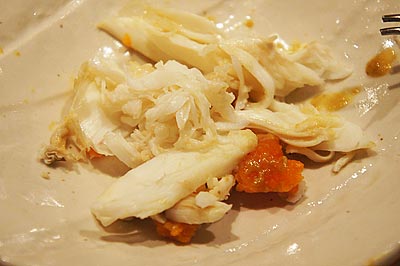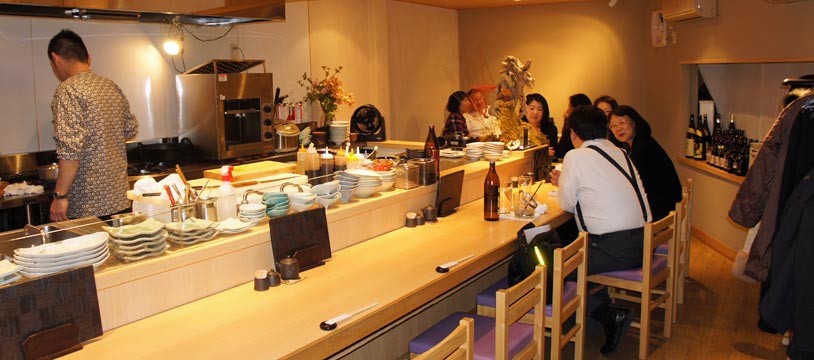- Yummy top
- Eateries and restaurants
- Uoyu - lunch restaurant
- Kanno
- Tokachiya
- Kitchen Nankai - Jinbocho
- Lamb Meat Tender
- Fujiyoshi - tempura restau.
- Enda - Japanese blue crab
- Fukuda - globefish pot
- Sugimoto
- Fuushi
- Soba restaurant
- Shinano - Akabanebashi
- Juwari-soba Inamuraya
- Ando and Korin
- Toranomon Sunaba
- Izakaya
- subLime and Kakinoki
- Donburi-bachi
- Renka
- Yoshida
- Daini-Chikarashuzo
- Sasagin
- Mugiya - soba izakaya
- Fukube
- Sasashin in Ningyo-cho
- Foreign cuisine
- Pizza Piazza
- Atelier de Fromage
- La Piccola Tavola
- Milieu - salad lunch
- Cafe Moskow - Spanish bar
- Sin Tong Kee
- Sekaihanten
- Miscellaneous
- Cheese & champignon party
- Natural Cheese Contest
- Donburi - rice bowl dish
- Home cooking
- Aji no nanban-zuke
- Spaghetti Carbonara
- Curry rice

Enda
Senju 2-4 2F, Adachi-ku, 120-0034 TokyoTel. 03-3882-2136
Sundays closed

Enda - Japanese blue crab
When I decided to take a home leave, an idea came to my mind; let me eat "gazami" - flower crab or Japanese blue crab.

Three gazami ready for steaming
Gazami used to be a highly popular species of crab of Tokyo Bay till the 1950s. When I was a small child I often ate gazami, as my parents’ house existed not far away from the coast of Tokyo Bay. At the time, Tokyo Bay, in particular in its part of Chiba Prefecture, still preserved most of its natural coast line and gazami were plentiful in the shallow sandy sea floor. Wives of crab fishers used to carry a large bamboo basket on their back filled with wood shavings to keep crabs alive for hours and to peddle the catch of the previous night from house to house in early morning. Immediately after having bought some of the fresh gazami, my mother put them in the boiling water of a large pot. The green color of the shell soon turned red and the delicacy was ready for eating.
It was more than 50 years ago when I ate gazami from Tokyo Bay for the last time. But, I vividly remember the excellent taste of gazami and I never found any other kinds of crab tastier than gazami. In Dar es Salaam, where I live now, crabs similar to gazami, but smaller, are sold at Fish Market, but they are dead and look to stink, though they remind me of the taste of gazami, the delicacy in my dream. Therefore when I planned my home leave I asked Sekizawa-san, a gourmet and extremely enthusiastic guy in finding out any delicious food, to find out a possibility in Tokyo to eat gazami caught in Japan and if possible in Tokyo Bay, but in no case imported from China or elsewhere.

Enda- chef placing the gazami on the plates
 Sekizawa-san managed to find a chef of a small Japanese kappou-style restaurant who promised to acquire good gazami. Enda-san, the chef of the restaurant, goes every day to Tsukiji Fish Market to buy fish he needs for the day. He said he can get gazami, though the number of gazami is not big even in Tsukiji, gazami is available almost every day.
Sekizawa-san managed to find a chef of a small Japanese kappou-style restaurant who promised to acquire good gazami. Enda-san, the chef of the restaurant, goes every day to Tsukiji Fish Market to buy fish he needs for the day. He said he can get gazami, though the number of gazami is not big even in Tsukiji, gazami is available almost every day.
Then we set the date, 21st of December, subject that the dinner was to be cancelled if Enda-san could not get gazami at the Market early that morning. Fortunately, we received a call from Enda-san, that he could get three live and good quality gazami.
Thanks to the efforts of Enda-san, when we reached his restaurant, three crabs were still alive and moving their nippers around. The best and simplest way of eating gazami is to boil or steam it and eat its meat with vinegar and soy sauce while it is still warm. Boiling is the common way of cooking at my parents’ house. But, steaming is said to keep the tasty soup within the shell better than boiling in water. Of course, Enda-san chose steaming. After 10 minutes or so, crabs were taken out from the steamer. Enda-san took off the upper part of the shell and served us the crab (see the picture below). I asked him to part the crab right and left and to cut each part into two so that we can take out the meat easily from the shell.

Unlike many other spieces of crab, mos of the edible part of gazami exists not in the legs but in the body.
Everything was ready for start eating. Then we engaged ourselves to take out the meat from the shell and everybody became silent as we concentrated so much in managing to get the delicacy. Crab eating is indeed not suitable for friendly chatting. However, the taste of gazami was heavenly. In particular, when we mixed the meat with egg and lever paste (we are told so, but are not sure that this tasty paste is lever of the crab.) the delicacy was incomparable.

After a few seconds a good portion of crab meat was collected.
After about 15 minutes’ concentration, we became relaxed and resumed chatting. We ate this evening not only gazami but a full dinner course for the year-end party including fugu (globefish) pot. We were not told exactly how much a gazami cost. However, one gazami should not be more expensive than US 40 or 50 dollars in light of what we paid for the whole dinner. Enda-san told us that the catch of gazami was not big and gazami is not always available even at Tsukiji Fish Market, but its price is not awfully high, because there are not many customers as the catch is not reliable. This evening gazami unfortunately did not come from Tokyo Bay, but from Mie Prefecture near Nagoya. But, anyhow they were caught in Japan. Sekizawa-san told me that we can buy gazami imported from Taiwan at Ameyoko Market near Ueno.
 Kitasenju station |
This was the first time for me to visit Kita-senju. Kita-senju is only the name of a railway station and the area is traditionally called Senju. Senju was the first and flourishing station of Nikko Highway during the Edo Period. At an important transportation hub, Senju was one of the popular red-light districts and it still retains this tradition. It is therefore understandable that a good restaurant like Enda can exist in Senju. Enda is located only a few steps away from Nikko Highway. It has a counter with 11 seats and a table for four persons. This is the ideal size of a restaurant that is taken care by one cook.
